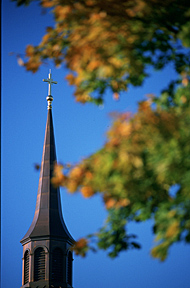Governance Overview
In the summer of 1994, Providence College restructured its governing body to a two-tier structure: a Corporation and a Board of Trustees (web site).
- Download Adobe Acrobat Reader
- Read the PC Articles of Incorporation and Charter (PDF)
- Read the By-Laws of Providence College (PDF)
Corporation
The Corporation shall possess and exercise all of the functions, rights, duties, powers, privileges, and responsibilities conferred upon or possessed by the College under its Charter and applicable law except insofar as such functions, rights, duties, powers, privileges, and responsibilities are herein delegated to the Board of Trustees.
The membership of the Corporation shall consist of twelve (12) members, vis: (i) The Bishop (or if at any time there shall exist a vacancy in the Office of the Bishop, the Administrator); (ii) the President of the College; (iii) the Provincial; (iv) the Chairperson of the Board of Trustees; and (v) the Vice-Chairperson of the Board of Trustees, each of whom shall be ex officio; four (4) Dominican friars elected by the Corporation; and three (3) lay persons elected by the Corporation.
The terms of office of the Bishop, the President of the College, the Provincial, and the Chairperson and Vice-Chairperson of the Board of Trustees shall be coterminous with the respective incumbency of each. The terms of all other Corporation members shall be three (3) years. No member of the Corporation except ex officio members shall serve more than three (3) full terms of three (3) years. Any person may be reelected a member of the Corporation after the expiration of two (2) years following the conclusion of a prior term. Any vacancy in the non ex officio membership of the Corporation shall be filled by election by the Corporation.
Board of Trustees
The Board of Trustees of the College shall have the authority to perform and act as necessary or consistent in the exercise of its power and authority in the complete governance of the affairs of the College not otherwise reserved to the Corporation. A Trustee’s relationship to, and role in, the affairs of the College shall be fiduciary in nature, requiring the Trustee’s judgment to be exercised in the best interests of the College as a whole, as distinguished from representation of any particular interest.
The Board of Trustees shall consist of not less than twenty-five (25) or more than forty-five (45) in number. Each member of the Corporation and the Executive Vice President of the College shall be ex officio members of the Board of Trustees. All other members shall be elected by the Corporation. The Board Affairs Committee (or its successor) of the Board of Trustees will send a list of candidates to the Corporation after the Board of Trustees has recommended transmittal of the list to the Corporation.
The term of ex officio members of the Board of Trustees shall be coterminous with their respective offices. All other members of the Board of Trustees shall be elected for a term of three (3) years and shall serve no more than three (3) full consecutive terms of three (3) years. Any elected person having served three (3) full terms may be reelected to the Board of Trustees after the expiration of two (2) years following the conclusion of the third term. The Corporation retains the right to terminate an elected member of the Board of Trustees if such action shall be deemed by the Corporation, in its sole discretion, to be required for the good of the College.
Currently, there are 41 members serving on the Trustees. The members of the College Corporation are also members of the Board of Trustees. The Board meets three times a year.
National Board of Advisors
National Board of Advisors (PDF)
Administration
The College president is the chief executive of the institution. The President’s Cabinet, consisting of the president, executive vice president, and eight vice presidents, is the primary organizational vehicle by which the College is administered. The Cabinet typically meets weekly to discuss major administrative issues and make policy decisions. Responsibility for implementing Cabinet decisions rests with the appropriate Vice President and/or the College president.






